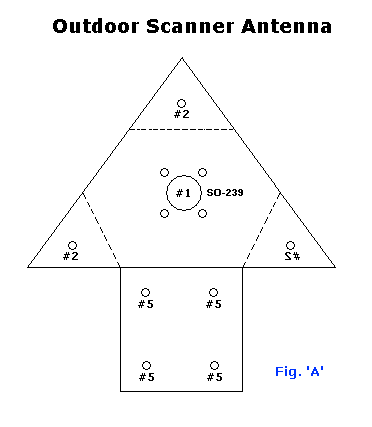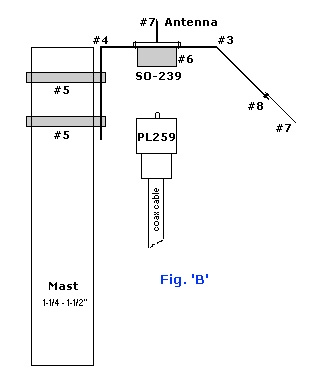

Outdoor Scanner Antenna:
One of the most commonly asked questions in some of the daily emails deals with reception improvements. The answer is
simple: use a better antenna. Designs are many and can cost from a few dollars for a homebrew type to a couple hundred
for a commercial antenna. Depending on your needs and wants, start off at least by making this one for indoor or
outdoor use. It is small enough to mount on an apartment balcony without problems from the landlord and should not
cost your more than about $10 plus the cable to connect to your antenna.
1) Get a piece of sheet aluminum or copper and cut it in the triangle shape as
shown. Leave enough of a strip, 5cm (2") wide and at least 5cm long, on one
of the sides.
2) Drill a hole in the middle (#1) and file it wide enough to mount the SO-239
chassis mount connector.
3) Drill 4 small holes around it, use the connector as template. Fasten the
connector with small machine nuts and bolts to the triangle plate.
4) Measure 5cm (2 inches) from each triangle point, one third of the length, and
draw a line across. It will look like the perforated lines in the top diagram.
5) In approx the middle of the "new" little triangles, drill a small hole (#2).
6) In the strip sticking out the side, drill two holes, for the U-clamp (#5), to
mount the plate on to the mast. Use the U-clamp as a template.
7) Now you need to bend the triangle along lines #3 at a 45° see Fig. B.
Bend the strip along line #4 to a 90° angle.
8) All that's left to do now, is to solder a metal rod (#7) in place. This rod
(piano wire) is available from hobby stores in a variety of diameters. You
need to find a diameter that will fit snugly into the PL-259 connector before
soldering. The length should be about 50cm. Solder the rod into the "tube"
socket (NOT the hole with the screw-thread -- thats where the cable goes).
9) Three more rods of the same length need fastening in the little holes (#2),
easiest to use speednuts (#8).
Put the rod in the loop end. Use RG-58 cable with PL-239 connectors to
connect the antenna to your scanner. For the back of the scanner you'll need
a PL-239 to Motorola adapter, or make your own.
And voila, an outdoor antenna of respectable reception, comparable to that of a commercial unit. For indoors, don't
even bother with the strip on the side, just the triangle shape. Use a string, or rubber band to hang it up (no metal
wire!)
I have designed this antenna for best performance on the 148-155 VHF band and 450-460 UHF.
The vertical rod is a wave for the 150Mhz band. Before installing it outside, put some acid-free grease or varnish/lacquer
over all connections, to prevent corrosion. I sprayed mine with varnish and dipped the tips of all the wires in red rubber
cement. Gives a very nice overall look. Do NOT use Silicon Glue or caulking of any
kind. The acidity of this stuff will eat through the copper in no time. Even the fumes are acidic. Regular Varso, or
varnish will work great. If you are going to use this antenna strictly indoors some short cuts can be taken.
Use bicycle spokes or piano wire for the metal rods (#7). Solder the vertical one straight into the SO-239 socket. At
the end of the other spokes, 4 in this case, bend a little loop (or eyelet) and fasten them directly to the holes in
the SO-239 connector using #6 nuts and bolts. Bend the spokes to form the 45° angles. The vertical spoke now
even has a loop to hang it from the ceiling -- again, use string or rubber band, NO METAL WIRE of any kind.
Calculate the length of the vertical to make it for other frequency ranges. A table of antenna lengths is listed
elsewhere on this site.
Another 1/4 wave model is described [HERE] by W4PNT.
Back to Ham Radio Page page
Copyright ©2004 - Tony van Roon, VA3AVR
Last Updated January 22, 2010


